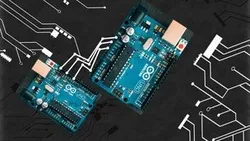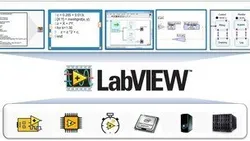
Interfacing with the Arduino 
This course introduces students to interfacing with the Arduino. It covers the use of sensors to receive inputs from the environment, and how to control lights, motors, and other actuators. Additionally, students will learn about analog and digital signal conversion, as well as Arduino-specific shields and software libraries. ▼
ADVERTISEMENT
Course Feature
![]() Cost:
Cost:
Free
![]() Provider:
Provider:
Coursera
![]() Certificate:
Certificate:
Paid Certification
![]() Language:
Language:
English
![]() Start Date:
Start Date:
10th Jul, 2023
Course Overview
❗The content presented here is sourced directly from Coursera platform. For comprehensive course details, including enrollment information, simply click on the 'Go to class' link on our website.
Updated in [March 06th, 2023]
This course, Interfacing with the Arduino, provides an introduction to the use of sensors and actuators with the Arduino microcontroller. Students will learn how to connect sensors to the Arduino, how to convert analog signals to digital signals, and how to use Arduino-specific shields and software libraries to interface with the real world. The course does not include discussion forums.
[Applications]
After this course, students can apply their knowledge of interfacing with the Arduino by creating projects that use sensors and actuators to interact with the environment. They can use the knowledge gained to program the Arduino to read and interpret sensor data, and to control actuators based on the data. Additionally, students can use the Arduino-specific shields and software libraries to interface with the real world.
[Career Paths]
1. Robotics Engineer: Robotics engineers design, build, and program robots. They use their knowledge of electronics, mechanics, and software engineering to create robots that can interact with the environment. Robotics engineers must be able to think creatively and solve complex problems. As the demand for robots increases, the need for robotics engineers is expected to grow.
2. Embedded Systems Engineer: Embedded systems engineers design and develop embedded systems, which are computer systems that are embedded into larger systems. They must be able to understand the hardware and software components of the system and be able to design and develop the system to meet the needs of the customer. As the demand for embedded systems increases, the need for embedded systems engineers is expected to grow.
3. IoT Developer: IoT developers design and develop Internet of Things (IoT) systems. They must be able to understand the hardware and software components of the system and be able to design and develop the system to meet the needs of the customer. As the demand for IoT systems increases, the need for IoT developers is expected to grow.
4. Arduino Programmer: Arduino programmers design and develop programs for the Arduino platform. They must be able to understand the hardware and software components of the system and be able to design and develop the system to meet the needs of the customer. As the demand for Arduino-based systems increases, the need for Arduino programmers is expected to grow.
[Education Paths]
1. Electrical Engineering: Electrical engineering is a field of engineering that deals with the study and application of electricity, electronics, and electromagnetism. Electrical engineers design, develop, test, and supervise the manufacture of electrical equipment, such as electric motors, radar and navigation systems, communications systems, and power generation equipment. With the increasing use of technology in everyday life, the demand for electrical engineers is expected to grow.
2. Computer Science: Computer science is the study of computers and their applications. It involves the design, development, and analysis of algorithms, software, and hardware. Computer scientists use their knowledge of computer systems to develop new technologies and solve problems. With the increasing use of technology in everyday life, the demand for computer scientists is expected to grow.
3. Robotics: Robotics is the study of robots and their applications. It involves the design, development, and analysis of robots and their components. Robotics engineers use their knowledge of robotics to develop new technologies and solve problems. With the increasing use of robots in everyday life, the demand for robotics engineers is expected to grow.
4. Mechatronics: Mechatronics is the study of the integration of mechanical, electrical, and computer engineering. It involves the design, development, and analysis of mechatronic systems. Mechatronics engineers use their knowledge of mechatronics to develop new technologies and solve problems. With the increasing use of mechatronic systems in everyday life, the demand for mechatronics engineers is expected to grow.
Course Syllabus
Module 1
IoT devices involve a combination of software and hardware. This module provides background on the basics of hardware design and wiring needed to build useful circuits. This module describes the functions of basic passive components and describes how to use them in simple circuits. This module also describes how to wire circuits together using a breadboard. The goal of this module is to enable students to design and implement the circuits they need to interact with basic sensors and actuators.Module 2
This module introduces sensors and actuators and discusses how to interface with them. We’ll examine different classes of sensors and actuators. For each type of sensor/actuator, we’ll examine the circuitry needed to interface with it. Additionally, we’ll take a look at the Arduino code needed to communicate with the sensors and actuators.Module 3
Module 4
Pros & Cons

Extensive information

Great insights into Arduino programming

Ideal for someone who wants to learn more on IoT

Talented faculty

Good overview course

Assignments not related to videos

Fast pace of weeks 3 and 4

Poor assessment quality

No student interaction

Slightly less information than desired
Course Provider

Provider Coursera's Stats at AZClass
Interfacing with the Arduino introduces students to how to use the Arduino. It covers using sensors to receive input from the environment and how to control lights, motors, and other actuators. Learners can learn how to use different types of sensors to sense the environment and how to connect them to Arduino. They can also learn how to convert an analog signal to digital and vice versa. Additionally, learners can learn to interface with the real world using Arduino-specific shields and shield software libraries.
Discussion and Reviews
0.0 (Based on 0 reviews)
Explore Similar Online Courses

Big Data Analytics with Hadoop and Apache Spark

Interior Design Basics & Principles

Python for Informatics: Exploring Information

Social Network Analysis

Introduction to Systematic Review and Meta-Analysis

The Analytics Edge

DCO042 - Python For Informatics

Causal Diagrams: Draw Your Assumptions Before Your Conclusions

Whole genome sequencing of bacterial genomes - tools and applications

Arduino Communication with SPI Protocol

Interfacing LabVIEW With Arduino via LINX


Start your review of Interfacing with the Arduino